Foundation Plugin
-
Parameters for the new Interior Bearing Module:
Basic Options:
Bearing Type: Post and Beam, Stud Wall, CMU
Bearing Height:
Footing Width:
Footing Depth:
Ftg. Offset Start:
Ftg. Offset End:
Sill Plate Offset:
Stemwall Offset:
Rebar Option: Yes/NoPost and Beam Options:
Beam Width:
Beam Depth:
Post Spacing:
Post Width:Stud Wall Options:
Stud Depth:
Stud Width:
Stud Spacing:
Top Plate Qty: 1,2,3
Top Plate Thk.:Rebar Options:
Ftg. Bar Dia.:
Ftg. Bar Qty.:Let me know if I'm missing anything. I haven't included a section for CMU yet since I need to do more research on that particular construction type.
-
Version 1.4.1 - 09.04.2019
- Enabled the "Draw Interior Bearing" tool with the following support types: Post & Beam, Stud Wall.
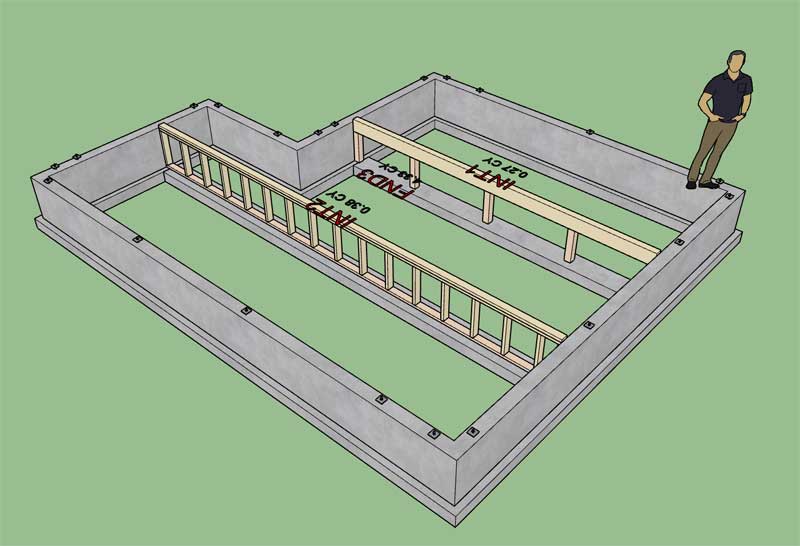
View model here:
3D Warehouse
3D Warehouse is a website of searchable, pre-made 3D models that works seamlessly with SketchUp.
(3dwarehouse.sketchup.com)
Now a video demonstrating the polyline stemwall, interior bearing and step tool all working together would be interesting.
-
Tutorial 6 - Polyline Stemwalls, Steps and Interior Bearings (13:27 min.):
View model here:
3D Warehouse
3D Warehouse is a website of searchable, pre-made 3D models that works seamlessly with SketchUp.
(3dwarehouse.sketchup.com)
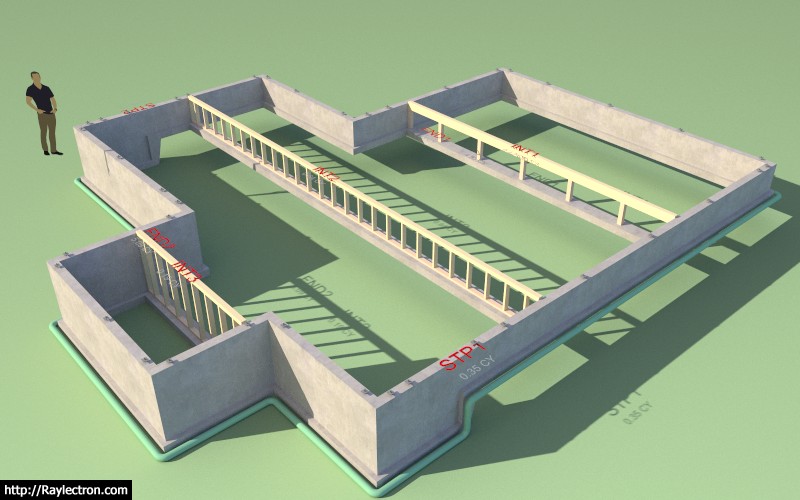
-
There has been some call to provide a CMU option for the polyline stemwall module. In order to represent CMU my intent was to not alter the model but just apply the appropriate material/texture as I am doing with the Wall plugin. However this method only really works with linear sections of walls (at least for the faces parallel to the Z plane):
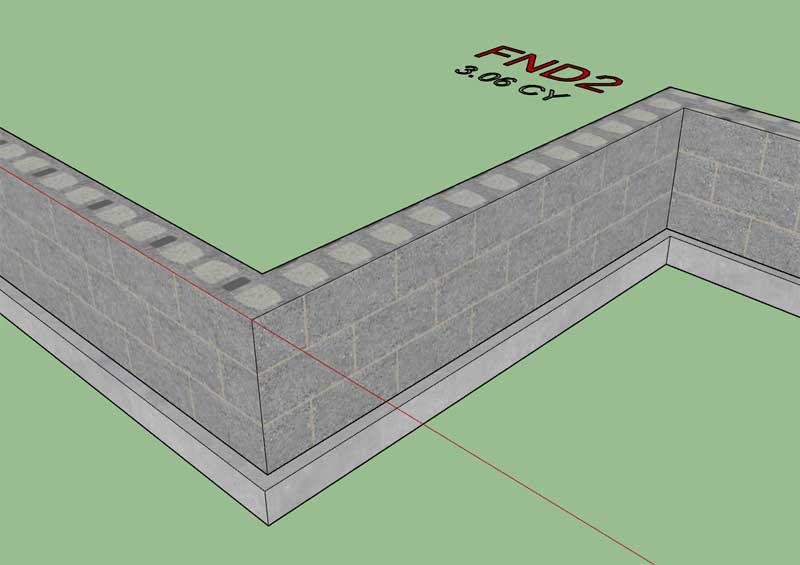
As you can see from the image/model the vertical faces come out just fine however the horizontal faces are a bit of a mess. I really don't want to change up the way I'm modeling the stemwall itself (ie. breaking it into linear segments) so the solution might be to simply provide a more generic material for the horizontal faces without any of the brick interior design, mortar lines etc... thoughts? It would look not quite as realistic when looking at the top of the CMU wall but it also wouldn't appear as confusing as the result shown here.
-
Medeek Live Training: Session 1
Scheduled time is 11:00 PST
This is my first attempt at live streaming so hopefully things go smoothly but I'm sure it will be a bit of a learning experience. The primary topics covered will be the recent additions to the foundation plugin however I am willing to open it up to other questions about all of the other plugins.
-
This bi-directional pattern (even though not as realistic) seems to be a decent compromise and provided the segments of the polyline stemwall are orthogonal and in length increments that are multiples of 24" the texture works:
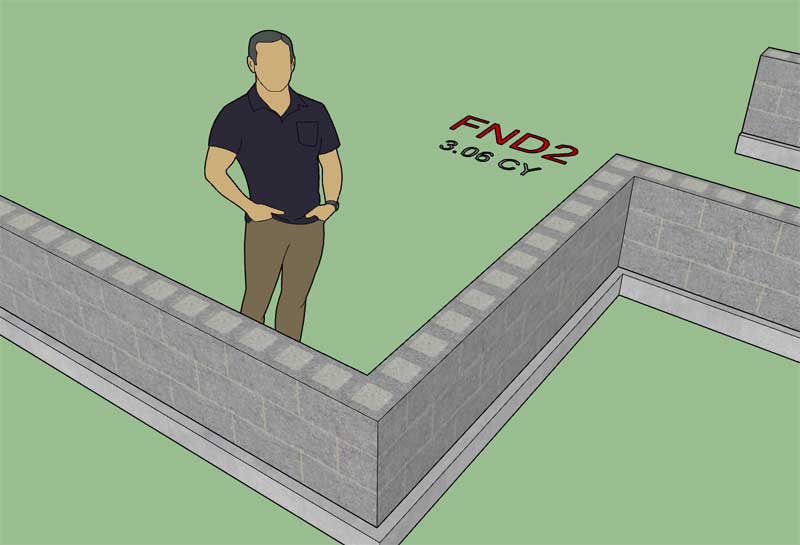
-
First look at a CMU polyline stemwall:
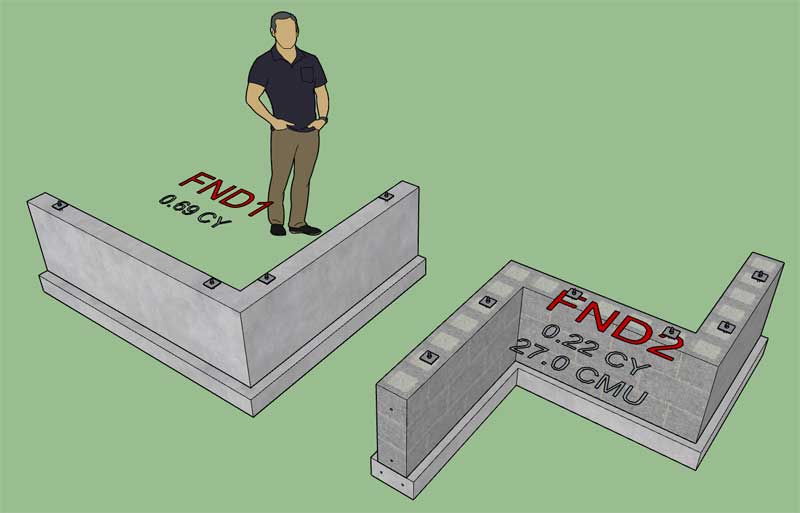
Note that the callout includes the number of CMU block calculated per the volume of the stemwall and the standard block size (16" x 8" x stemwidth). For now the nominal depth and height of the CMU block is hard coded to these typical values found in North American construction but I will probably provide some parameters in the global settings where these values can be customized.
The horizontal face texture I'm using only really works well for standard CMU block sizes and if the walls are orthogonal and in 2' length increments. I don't have a work around yet to deal with exceptions. I will give this some additional thought and come up with a better solution.
Now all I need to do is enable CMU for the stemwall step tool and then I'll roll a new release.
This update is a direct result of discussions had in today's training session, thank-you to everyone who participated and providing feedback which will directly impact the plugins' development.
-
Version 1.4.2 - 09.05.2019
- Enabled CMU blocks for polyline stemwall foundations.
- Enabled CMU blocks for stemwall steps.
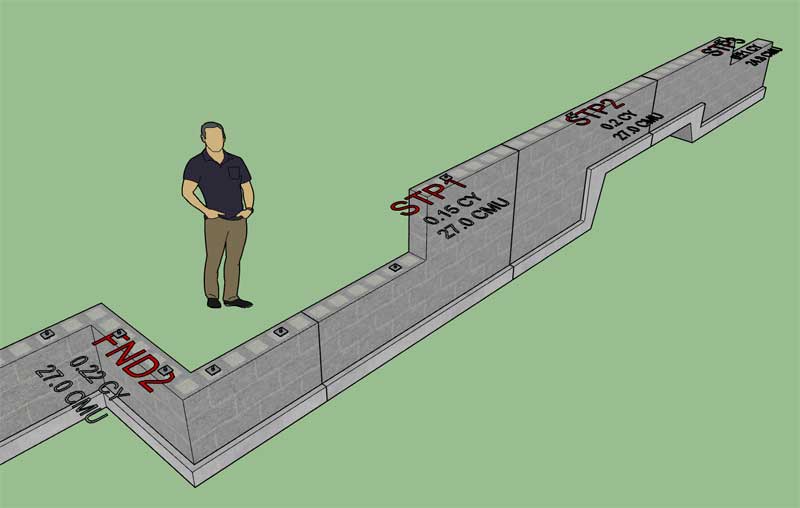
** NOTE **
If you have previously installed the plugin and are upgrading to this latest version in order to utilize the new CMU feature please do the following action once you have installed Version 1.4.2:
1.) Click on the global settings tab.
2.) Click on the Layers tab within the Global Settings.This action will initialize the “CMU Layer” for future use. New installations of the plugin will automatically initialize the new layer when they enable the layers options for the first time. This action is only required for those users upgrading their plugin installation.
-
I'm interested in putting the new polyline stemwall tool through its paces. If you have a fairly complex foundation plan that you think I should try and model please email me a PDF of it.
-
Version 1.4.2 - 09.06.2019
- Fixed a bug with the rebar in closed loop stemwall assemblies.
Critical bug fix, I strongly suggest upgrading to this version of the plugin.
-
I've moved to the complex roof development but there are still a number of glaring holes in the foundation plugin. To get a better feel for how well it would work I modeled up a foundation for a residence that I did some local engineering for a couple of years ago:
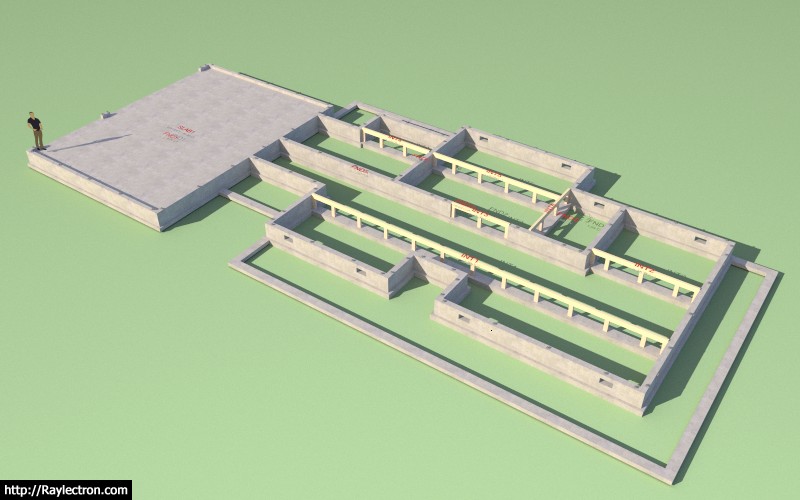
View model here:
3D Warehouse
3D Warehouse is a website of searchable, pre-made 3D models that works seamlessly with SketchUp.
(3dwarehouse.sketchup.com)
Really the only manual edits that were required was the blockouts for the garage doors and the footings for the porch roofs. The following list summarizes some areas that need further development:
1.) Need some sort of option for garage door block outs.
2.) Need the ability to create holes in stemwalls (crawl access, windows, doors)
3.) Add interior footings to regular slabs, similar to the interior footing tool for slab-on-grade foundations.
4.) Stemwall opening tool should also remove any conflicting rebar (boolean subtraction).
5.) Still need to add the tool for a simple polyline footing (ie. porch footing shown). The workaround is to create a stemwall and then manually delete the stemwall leaving the footing portion.I'm also thinking about creating a material list table that summarizes quantities, similar to the legend I generate in the electrical plugin.
So much to do, I really need a whole team of developers to get everything done I need to do.
What would be interesting to know is how much time it would take to manually model up the equivalent geometry, also bear in mind that there would be no parametrics available so if you need to adjust something it would require considerably more time and effort to make that change. With the plugin if I need to adjust something like anchor bolt spacing I simply edit the assembly with a right click and the changes are instantaneous.
Modeling time was about 30 minutes. Most of that time was transcribing dimensions from a large, crumpled set of paper plans. The rest of the time was largely spent on fiddling with the garage door block outs and then trimming the rebar back. As it stands now I do think the plugin offers some significant time savings but there is much that remains to be done.
-
Impressive perseverance, talent, and dedication!
-
Combining a slab-on-grade with a stemwall footing (with steps):
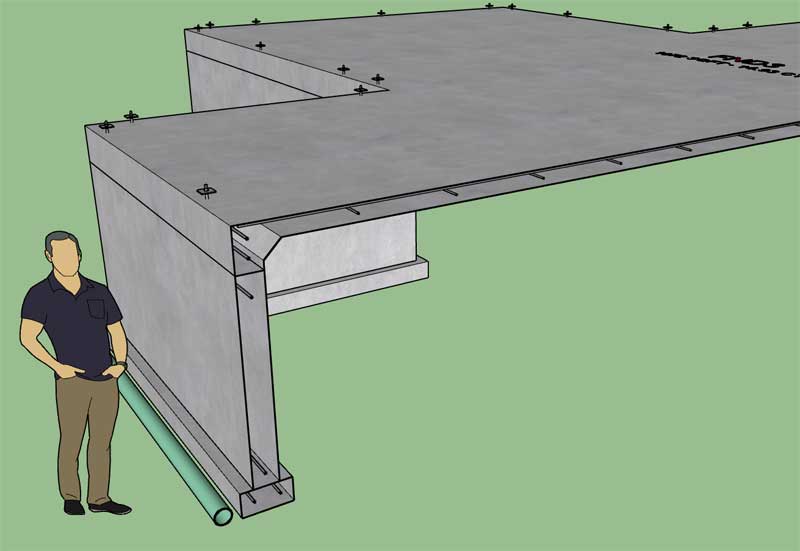
View model here:
3D Warehouse
3D Warehouse is a website of searchable, pre-made 3D models that works seamlessly with SketchUp.
(3dwarehouse.sketchup.com)
-
Version 1.4.3 - 09.07.2019
- Enabled the "Draw Strip Footing" tool with the following advanced options: rebar, drain pipe.
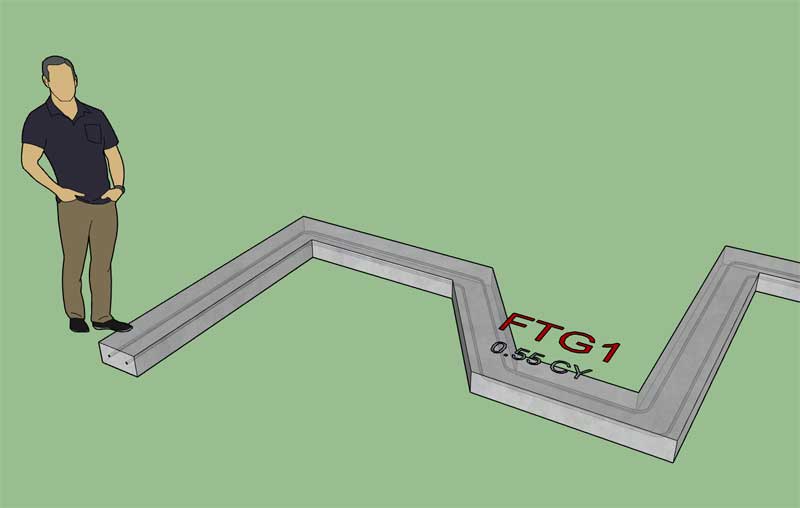
Similar to the polyline stemwall tool you can create closed loop polylines (polygons) as well as simple linear sections of footing.
Similar to the polyline stemwall tool the point selection of the tool is terminated with the "DOWN" arrow key.
The horizontal bar option is shown in the menu but is currently not enabled. I need to give this option some additional consideration before I make it live.
-
After working through the complex foundation on Friday, and having to manually create stemwall blockouts for garage doors I've come to the conclusion that a stemwall blockout tool is critical to the success of this plugin.
I guess I'm just a lazy 3D modeler, but even having to push/pull a blockout is too much work for me and then it ultimately breaks the parametrics of that particular stemwall assembly, so manual edits should be avoided whenever possible.
Yet another toolbar:

Like the Wall plugin the Foundation plugin is starting to collect quite a few toolbars, this will be the sixth toolbar for this plugin. I'm starting to run out of screen real estate, I may have to do something about that, I'm not sure what yet.
The problem is that the plugins need to be able to do a lot of things, so there are a lot of tools and each operation/function needs its own icon or button to instigate it. I've managed to wrap some functions into context menus but some operations are better presented as a direct icon in my opinion.
-
First look at some column footings (spread footings) with and without pedestals:
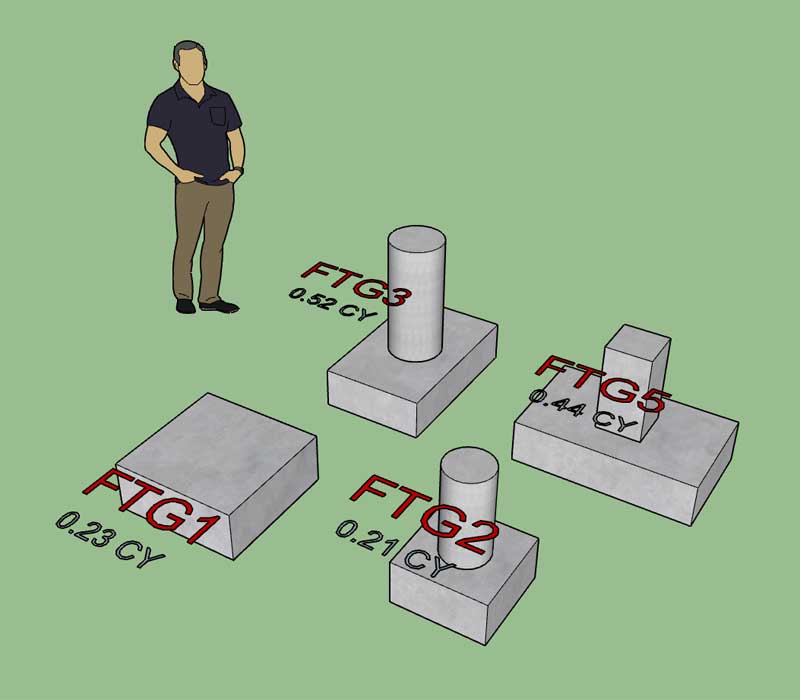
I've decided not to add the column portion into the Foundation plugin, that will be part of the Wall plugin.
I just need to add a bit of rebar into these assemblies and then I will roll a new version.
-
Version 1.4.4 - 09.09.2019
- Enabled the "Draw Column Footing" tool with the following footing types: spread footing, spread footing w/ pier.
- Added transverse and longitudinal rebar for column footings.
- Added the Stemwall Blockout toolbar and icons.

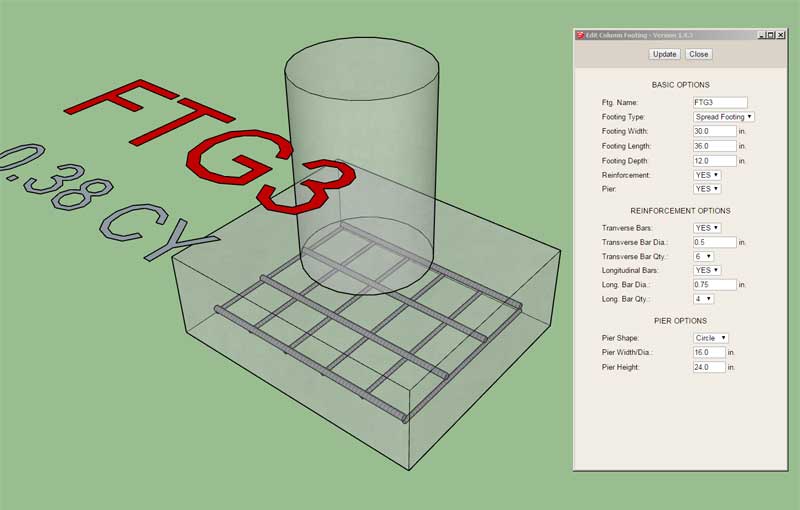
The Draw Column Footing tool is the 4th icon on the main toolbar.
This is a really easy tool to use, I highly recommend upgrading to the latest version to take advantage of it.
The blockout toolbar has been added however these tools will not be functional until the next release.
With the pier option enabled I would be interested in adding in options for vertical rebar (with hooks) and possibly hoops, but I first would like some more feedback in this regard.
-
How is this integrated with the rest of the Foundation--or does it just create an isolated component from which you position copies into the model?
-
@pbacot said:
How is this integrated with the rest of the Foundation--or does it just create an isolated component from which you position copies into the model?
This tool creates separate footing assemblies within the model. It is separate from the rest of any other foundation assemblies.
These footing assemblies can be edited and moved anywhere within the model.
View model here:
3D Warehouse
3D Warehouse is a website of searchable, pre-made 3D models that works seamlessly with SketchUp.
(3dwarehouse.sketchup.com)
-
For concrete piers resting on a spread footing I was kind of thinking something along these lines for the rebar:
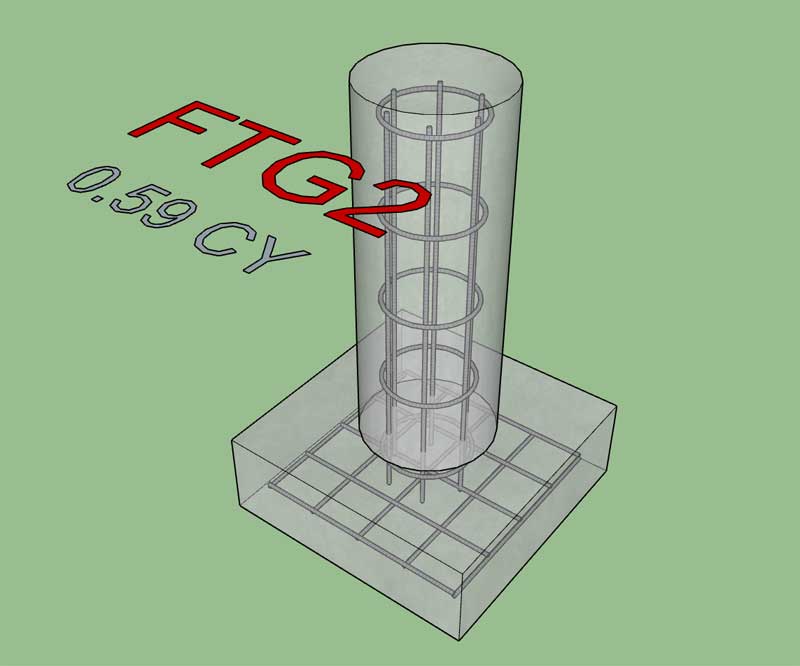
However, one would probably want the vertical bars to hook into the spread footing rather than terminate as shown.
Parameters might be something like:
Vertical Bars: Yes/No
Vert. Bar Dia.:
Vert. Bar Qty.: 2,4,6,8Hoop Bars: Yes/No
Hoop Bar Dia.:
Hoop Spacing:Let's try to avoid taking it to this extreme though:

Advertisement








